EMAIL MARKETING
How to Put Together Interesting Abandoned Cart Emails (and Examples)
Online shoppers are notoriously fickle, and why shouldn’t they be?
There are so many options and avenues at their fingertips that there’s no sense in wildly committing to the first products they see. The multi-step checkout process allows them to toy with potential purchases — chalk certain items down as likely buys while they look around for alternatives.
From the standpoint of a seller, of course, this can be extremely frustrating. Just when a site visitor has heaped their cart with products and taken the first step in the checkout phase, it all goes up in smoke. The interested party disappears from the site, leaving behind all those items.
To combat this, every sensible online merchant automates cart abandonment emails to trigger when this happens. The goal? To tempt back the near-misses and turn those abandoned carts into sales. But they’re so common that they easily get dull and predictable. If what’s on your site doesn’t do enough to hold someone’s attention, you won’t get anywhere with a boring email.
So, if you want to optimize the results you get from your cart abandonment email campaigns, you need to make them more interesting.
What is an Abandoned Cart Email?
An abandoned cart email is an automated message sent to a prospect’s email address when they’ve put items in an online shopping cart and then left the page without making a purchase. The idea is to re-engage with a potential customer at an opportune time — namely, at the point where you know they’re interested in your product or service. Still, they need a bit more encouragement to actually seal the deal.
About 70% of shoppers will abandon their cart before checkout. Among the most common reasons for doing so are:
- High shipping costs
- Taxes or other added fees
- Being asked to create an account
- Delivery estimates are too slow
- An overly long or complicated checkout process
With abandoned cart emails, brands give themselves one last chance to show prospects their purchase is worth overcoming whatever hurdle originally turned them away from the site. It won’t convert every loss into a sale, but it will keep a few from falling through the cracks — and that can make a big difference in overall sales quarter after quarter.
Why are Abandoned Cart Emails Effective?
Of the abandoned cart emails that go out, 45% are opened, and about 11% lead to a completed purchase. That open rate jumps to 63% when you send three abandoned cart emails.
What makes this type of outreach so effective is that it serves as a well-timed reminder to a prospect about what they left behind. If they see a product after abandoning it and realize it’s still something they’re interested in, they may be willing to overlook whatever obstacle originally stood in their way. Brands can also sweeten the deal — and possibly increase their conversion rates — by throwing in a discount, such as free shipping or 10% off the purchase.
What are the Most Important Parts of an Abandoned Cart Email?
There are three major components to any abandoned cart email: the subject line, the body copy, and the personalization of the content.
The email subject line is largely what decides whether a prospect opens up the abandoned cart email in the first place. It should be catchy and on-brand, and it should get straight to the point of what the message is about. If there’s an incentive inside, that should be made clear in the subject line too.
Body copy is also key. It should be clear and concise, and it should make direct reference to the product(s) that the prospect left behind. This speaks to the third essential piece of the abandoned cart email puzzle, which is personalization, particularly in terms of the items. The ultimate goal is to lay out what the CTA is (finishing the checkout process) and then lead to that action as efficiently as possible.
When to Send Abandoned Cart Emails
Timing can be a huge deciding factor in whether an abandoned cart emails get the job done, with quicker sends usually yielding better results. If you wait too long, you risk letting the prospect forget about the shopping experience — and forget why they were that interested in the first place.
If we go off the three-email structure, your best bet is to send the first email as soon as possible — ideally within the first hour after abandonment — followed by a second email at least 24 hours after that and a third email after another 24 hours. If none of those emails are successful, let it go.
Ways to Measure Success
Tracking how many abandoned cart emails lead to sales is a clear marker of success, but it’s not the only one. Other email metrics that you should be looking at in regards to cart abandonment and related outreach include:
- Change in average order value lost. How much are abandoned carts costing you, and how is your abandoned cart email strategy impacting that cost?
- Click-through rates. How many abandoned cart emails are getting people to re-engage on the site, including those who re-engage and still don’t complete a purchase?
- Email capture rates. Your abandoned cart emails can lead to other important conversions, including having an individual supply their email address and opt-in to further engagement.
You should also be working on the back-end to try and identify what’s standing in the way of more sales and what you can do to fix it. Simplifying your checkout process alone could make a huge difference in how often items get left behind.
7 Ways to Make Your Abandoned Cart Emails More Interesting
1. Reiterate the Main Selling Points
Very commonly, cart abandonment emails will simply list the items left behind and advise that they’re still on offer — handy for prospective buyers who simply got distracted and forgot to finish their purchases, but not much use to those who actually decided against buying (for whatever reason). It makes no sense to simply repeat a failed tactic.
Regardless of the reason behind an email recipient failing to complete their order, you’re best served adding the big selling points for the listed products to their email. If they were already sold on them and simply had to leave for some emergency, the extra rhetoric won’t discourage them from continuing, and if they left because they decided otherwise, seeing the benefits clearly restated might just convince them that they were wrong to leave.
2. Throw In Some Small Incentives
There’s no shortage of competition in the eCommerce world, so retailers need to work extremely hard to stay viable. This tends to result in similar prices across the board — going too high will run you out of contention (people can easily shop around to find cheaper listings) while going too low will destroy your profit on items with razor-thin margins, to begin with.
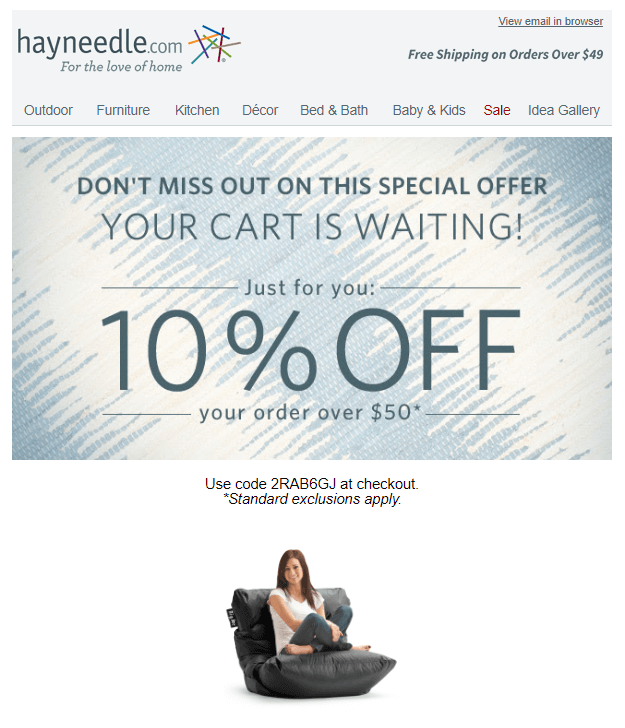
The good news about that is that even a very modest discount can often be enough to convince someone to complete an order, particularly when it’s offered out of nowhere in a cart abandonment email. Or you could provide a different kind of incentive: a free gift included with the order, for instance.
3. Tell a Creative Story
Most eCommerce site copy comes across as fairly generic. You have basic product details, key features, customer reviews, warranty details, and relevant images. The persuasive burden for a given listing is placed on the visual presentation in combination with the innate appeal of the product — which means that two websites offering the same item will have very similar pages.
But you don’t have to settle for that, particularly in your cart abandonment emails. Even if you’re reluctant to get too creative with your on-page copy (perhaps fearing the consequences for SEO), you can easily get more relaxed with your email copy.
Allow some whimsy to creep in. Tell them how sad you are that they didn’t complete your order and that your adorable office puppy is looking heartbroken. A little humor (executed well) can really get people on your side, leading them to want to support your brand with their patronage.
4. Lean on FOMO Elements
Someone looks at the products on your site, nearly buys them, then decides against it. There’s clearly no rush driving their actions (at least pertaining to your site in particular). If you email them to say something that effectively amounts to “Hey, these items are still here! You forgot them!” then you’re not changing that.
You can change this using FOMO (Fear Of Missing Out), the rhetorical powerhouse that readily compels us to take action because we’re worried that something great will pass us by.
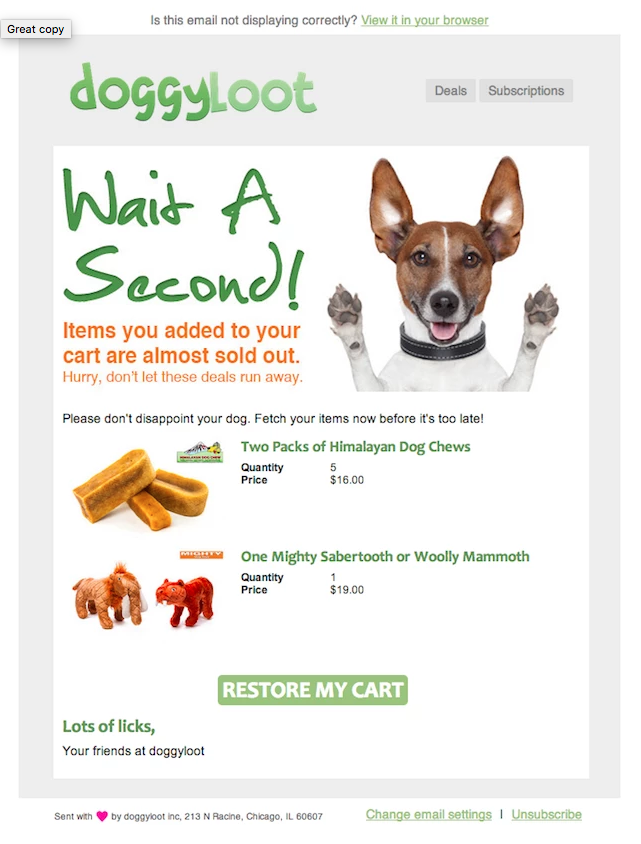
Instead of just listing the left-behind products, show their stock levels too, or simply note that they’re going quickly (even if they’re not). Lead the recipient to believe that their opportunity to buy isn’t indefinite. If they don’t act soon, their time will run out.
5. Alternatively, Play It Cool
FOMO is strong, but it doesn’t always work.
It’s really a hard-line gambit: if they’re really on the fence about wanting the item, the effort to hurry them may well cause them to conclusively decide against it. But that’s not the only negative effect it could have, because it might also lead them to dislike your business in general. People don’t like feeling hurried.
So if it’s more fitting of the circumstances, you can take the opposite tack and play it cool. Instead of leading them to think that they need to decide immediately, let them know that there’s no rush. They can change their mind whenever they want, and the great products (and great offers) will be there when they’re ready, no matter when (or how) they want to buy from you.
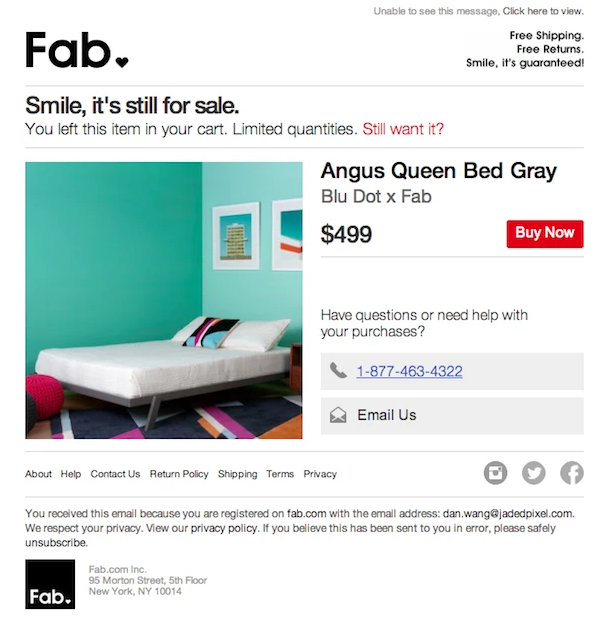
After all, assuming you’re using a multi-channel eCommerce platform, there’ll be nothing stopping them from changing their mind in the middle of the night and ordering from their phone through a chatbot in a messaging application (unlikely, perhaps, but completely possible).
This works as a display of confidence, shifting their perception of the situation and (possibly) driving them to want the products again. Think of a child refusing to do something they enjoy because their parents ordered them to — once that pressure goes away, they can make a free decision and follow their personal preferences.
6. Recommend Some Comparable Items
Suppose that nothing you do in your email, from restating the benefits of the abandoned items to offering a discount, has any effect on the recipient’s inclination to buy. They already made their mind up about those items, firmly concluding that they were no longer interested. But that doesn’t mean they lack interest in comparable items — maybe they just read some reviews and concluded that those specific products weren’t worth buying.
To cater to this, try listing some recommended products along with the abandoned items. If the stats of your online store show that 40% of the people who view a particular laptop go on to buy a totally different laptop, then that’s an obvious inclusion in a cart abandonment email to someone who left that first laptop in their cart.
7. Get the Right Automation Tools
Even if you have a fool-proof strategy for reigniting the interest of abandoned cart shoppers, you need the right tools to pull it off. Sign up for a free Benchmark Email account to test out our light email automation so you can automate email follow-up and our eCommerce Block feature, which allows users to promote their products via email. Both will help you turn abandoned carts into fresh sales for your business.
Sending cart abandonment emails isn’t enough in itself to make the most of your near-misses. You need to take the time to optimize them, setting them apart from those of your competitors — and these tactics will help you do just that.
Seen at: Benchmarkemail.com
EMAIL MARKETING
Unveiling the Future of Email Marketing: 4 Trends to Revolutionize Engagement

In today’s fast-paced digital landscape, the efficacy of email marketing hinges not only on the delivery of messages but also on their ability to resonate with audiences and drive meaningful interactions. Gone are the days of generic blasts; instead, companies are increasingly turning to innovative strategies to captivate their subscribers. Here, we delve into four emerging trends poised to redefine the realm of email marketing, promising to elevate engagement and drive conversions.
1. User-Generated Content (UGC) Takes Center Stage
User-generated content (UGC) emerges as a potent tool in the arsenal of email marketers, facilitating authentic connections with audiences while amplifying brand visibility. From customer reviews to social media posts, UGC offers a dynamic and relatable portrayal of products and services, resonating with consumers in the era of “new sincerity.”
By harnessing UGC within newsletters, brands gain invaluable insights into consumer preferences and behaviors, fostering trust and credibility. Strategies such as incentivized contests or social media challenges empower users to contribute content willingly, fueling a steady stream of authentic engagement.
2. Augmented and Virtual Realities (AR/VR) Transform Experiences
Augmented reality (AR) and virtual reality (VR) technologies emerge as game-changers in the realm of email marketing, offering immersive experiences that captivate and compel audiences. While VR may require substantial investments and specialized equipment, AR presents a more accessible avenue for brands to showcase products and drive engagement.
From interactive product demonstrations to virtual try-on experiences, AR/VR initiatives promise to revolutionize email campaigns, offering users a glimpse into a digitally enhanced world. While technical constraints may limit current implementations, ongoing advancements herald a future where AR/VR seamlessly integrate into email communication, enriching brand experiences.
3. Omnichannel Integration Enhances Connectivity
The advent of omnichannel marketing heralds a new era of seamless connectivity, enabling brands to orchestrate cohesive experiences across diverse touchpoints. By unifying customer interactions across websites, offline stores, and email communications, businesses cultivate deeper insights and deliver personalized content tailored to individual preferences.
Omnichannel integration not only streamlines the customer journey but also fosters brand loyalty by offering consistent and personalized experiences. Whether browsing online, engaging in-store, or interacting via email, customers encounter a unified brand identity, enhancing engagement and driving conversions.
4. Hyper-Segmentation and Personalization Drive Relevance
In an age defined by personalized experiences, hyper-segmentation emerges as a cornerstone of effective email marketing strategies. By dissecting audiences into granular segments based on demographics, behaviors, and preferences, brands can deliver tailored content that resonates on a profound level.
Utilizing advanced email marketing platforms, businesses can leverage hyper-segmentation to craft personalized campaigns that speak directly to individual interests and needs. From dynamic product recommendations to targeted promotions, personalized emails foster a sense of relevance and exclusivity, driving engagement and fostering long-term customer relationships.
In conclusion, the future of email marketing lies in innovation and adaptation, with brands leveraging cutting-edge technologies and strategic approaches to engage audiences effectively. By embracing trends such as user-generated content, augmented reality, omnichannel integration, and hyper-segmentation, businesses can unlock new realms of engagement, driving meaningful interactions and fostering brand loyalty in an ever-evolving digital landscape.
EMAIL MARKETING
Top Email Marketing Strategies To Use For Q4
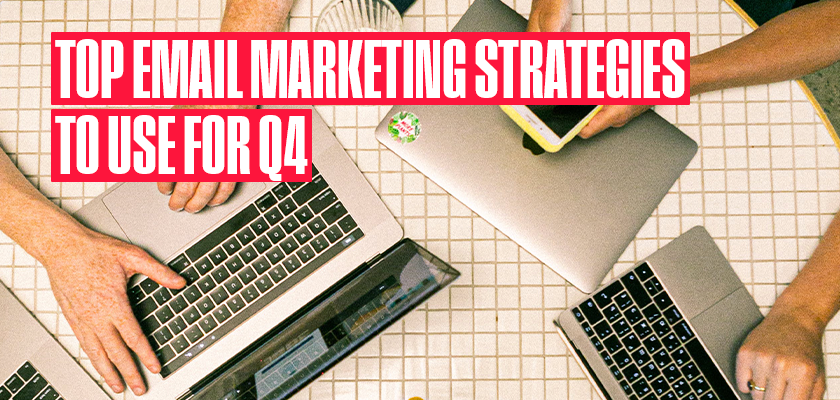
As we approach the Q4 period, it’s never too early to start preparing for your Black Friday and Cyber Monday email marketing strategy. Once Black Friday week hits, our inboxes are filled with a hurricane of brands fighting for attention, each with the ‘biggest’ and the ‘best’ offers you won’t get anywhere else.
To set your brand apart from the competition, it’s crucial to plan ahead. Over 60% of brands send out multiple emails over the course of the Black Friday/ Cyber Monday weekend, and it’s a perfect time to up your brand awareness ahead of the Christmas shopping season.
If you’re not sure where to start with Q4 planning or need some last-minute tips to enhance your strategy, we’ve outlined some top email marketing strategies to incorporate into your plans!
1. Send Pre-Black Friday Emails
Sending pre-Black Friday emails is great for keeping your brand at the forefront of people’s minds ahead of the big day. Not only will a pre-Black Friday email let your audience know about your upcoming event, but it will also ensure that your audience is regularly checking in on your brand throughout the Q4 period.
Additionally, sending pre-Black Friday emails is beneficial for A/B testing. Sending out different formats of emails with minor tweaks, such as the CTAs or subject lines, can help you determine what your audience is more likely to engage with so you can then tailor your Black Friday strategy accordingly.
2. Run a Lead Gen
It might seem like a given, but ahead of Black Friday, it’s beneficial to give your email list a much-needed boost. A simple but effective way to do this is to run a lead-generation advertising campaign. For example, offering your audience the chance to win a prize in return for submitting details, such as their email address, is a quick and easy way to increase your list size. Similarly, refreshing your pop-up on-site with an irresistible offer will also contribute to gaining new profiles.
3. Offer Something Unexpected
Email marketers only have 3 seconds to capture the attention of their readers, which isn’t surprising due to the amount of emails the average person will receive daily. If an email isn’t driving you to click on it, it swiftly gets forgotten about and lost within their inbox. Over Black Friday, to avoid this happening, make sure you’re offering something unexpected, whether that’s a mystery discount or a gift with each purchase!
One of the worst things you can do over Black Friday is to overcomplicate your promotions. If you’re offering multiple promotions and codes, things can get a bit too hectic. To make it as simple as possible, consider running a standard “up to” percentage amount. If you want to include a code, it helps to have this auto-applied at checkout to avoid customers dropping off if they input it incorrectly. In the design of your email, make sure the promotion is clearly highlighted within the design so it can’t be missed, and also referenced in the body copy and subject lines too!
5. Create An Effective Design
Creating an effective design is one thing, but how do you know what works? To improve your email campaigns, consider running an A/B test to pinpoint which elements of your design are improving the CTR and which are hindering it.
Highlighting metrics such as colour, font size, and CTAs can instantly impact whether people will click through or discard! If a consumer clicks on your email, you’ll have, on average, 11 seconds to keep their attention, so making sure your design stands out for the wave of other Black Friday content is key! Keep the design of your email reflective of your branding but with stand-out elements specifically for the shopping season.
6. Make Use Of CTAs
CTAs (call-to-action) are one of the most underrated parts of any email campaign, especially over the Black Friday period. They’re one of the driving forces behind making your email recipients turn into passive readers to customers. One key way to make your CTAs stand out is to make use of bright and bold colours that will attract and hold attention. Additionally, it’s important to think about the placement of your CTAs to increase your click-through rate, make sure the copy used is clear and concise (between two and five words) and use actionable language.
7. Focus On Subject Lines
Subject lines are make or break for every email campaign. Over Black Friday, consumers’ inboxes are cluttered with emails, so it’s important to stand out. It’s estimated that on Black Friday, 116.5 million emails from brands were sent out (more than any other day), and Black Friday sees the highest number of emails opened and clicked. To prevent your emails from being lost in the void, having a cracking subject line to stand out from competitors is everything.
The secret to a great subject line is to keep it short and snappy. On average, subject lines with 50 characters or less tend to get an average of 12% higher open rates and 75% higher click-through rates. Including emojis within subject lines has been seen to increase click-through-rates by as much as 28%!
Additionally, it helps to use language that will really pique your audience’s interest, stay away from any overused cliches and keep them as attention-grabbing as possible.
8. Prep for Cyber Monday
To plan an effective Black Friday, it’s crucial to prepare for Cyber events too. With Cyber following straight after, it’s easy to forget about it or not prioritise it as much as Black Friday, however, it’s still an extremely profitable day! To make the most of it, create dedicated campaigns and tailor your online sales messaging so that it focuses on driving urgency.
9. Incorporate SMS into Your Strategy
Sometimes the importance of SMS can be overlooked because a lot of brands assume that text messages won’t fit in with their brand. However, it’s a no-brainer for reaching even more customers. On average, 82% of people engage with marketing content on their smartphones, so it’s something to definitely explore, especially over the busy shopping period.
To gain SMS sign-ups, you can effectively tie your SMS campaign in with your lead generation and ask for customers to fill out their phone number as well as their email address. That way, they’ll be opted into your send list. It can also be used to send reminders when sales have launched or when offers are coming to a close.
Despite having only 160 characters to work with, SMS campaigns are longer than recommended email subject lines, so it can be just as, if not more effective than email marketing campaigns.
EMAIL MARKETING
Mastering Email A/B Testing for Mobile Apps: The Ultimate Guide
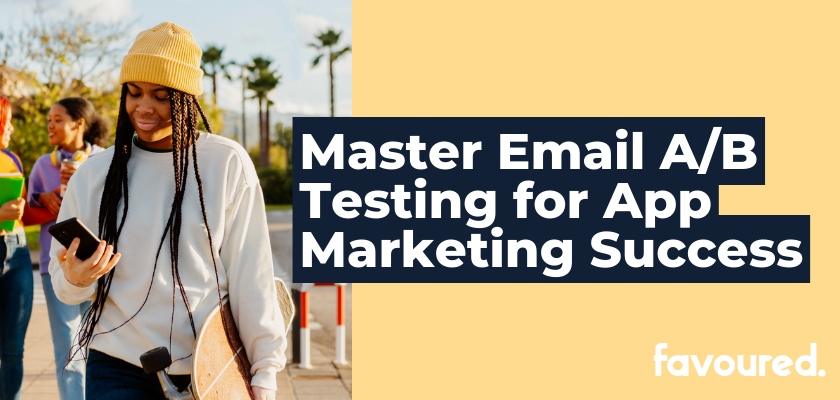
Welcome to the world of email A/B testing for mobile apps!
Here at Favoured, we’re all about delivering the best results for our clients, and that includes mastering the art of email marketing. In this guide, we’ll take you through the essentials of A/B testing your email campaigns to achieve maximum success for your mobile app.
What Is Email A/B Testing?
Email A/B testing, also known as split testing, is a method used to compare two or more variations of an email campaign to determine which one performs better. The goal is to identify the version that resonates most with your target audience, ultimately leading to higher open rates, click-through rates, and overall engagement.
In the context of mobile apps, email A/B testing can be particularly valuable, as it helps you fine-tune your marketing messages to drive user acquisition, engagement, and retention.
Benefits Of Email A/B Testing
There are numerous advantages to incorporating A/B testing into your email marketing strategy for mobile apps. Some of the key benefits include:
- Improved open rates: By testing different subject lines, you can identify which ones capture your audience’s attention and entice them to open your emails.
- Increased click-through rates: Experimenting with various email elements, such as CTAs and layout, can help you determine the most effective ways to encourage recipients to take action.
- Enhanced engagement: A/B testing allows you to create more relevant and engaging content for your target audience, resulting in higher conversion rates and stronger user relationships.
- Data-driven decision making: With A/B testing, you can make informed decisions based on actual user behaviour, rather than relying on assumptions or gut feelings.
Key Metrics To Track
When conducting email A/B tests, it’s essential to track specific metrics to gauge the success of your campaigns. Some of the most critical metrics to monitor include:
- Open rate: The percentage of recipients who open your email. This metric can help you evaluate the effectiveness of your subject lines.
- Click-through rate (CTR): The percentage of recipients who click on a link within your email. A high CTR can indicate that your email content is engaging and relevant.
- Conversion rate: The percentage of recipients who take the desired action after clicking a link in your email, such as downloading your app, making a purchase, or signing up for a newsletter.
- Unsubscribe rate: The percentage of recipients who opt out of receiving future emails from you. A high unsubscribe rate may suggest that your email content is not resonating with your audience.
Understanding the basics of email A/B testing is the first step towards optimising your mobile app marketing campaigns. By grasping the concept, benefits, and key metrics of A/B testing, you’ll be well-equipped to make data-driven decisions that drive real results for your mobile app.
Setting Up Your Test
Defining Your Goal
Before you start setting up your A/B test, it’s crucial to determine the primary objective of your test. Having a clear goal will help you focus your efforts and make data-driven decisions based on the results. Your goal should align with your overall mobile app marketing strategy and be specific, measurable, attainable, relevant, and time-bound (SMART). Examples of goals for email A/B tests include:
- Increasing the open rate by 10% within 30 days
- Boosting the click-through rate by 15% within 60 days
- Reducing the unsubscribe rate by 5% within 45 days
Selecting Variables To Test
Once you’ve set your goal, it’s time to choose the variables to test in your email campaign. The variables you select should have a direct impact on your goal and be something you can measure. Here are some common email elements to consider testing:
- Subject lines: Test different wording, phrasing, or personalisation techniques to capture your audience’s attention.
- Email content: Experiment with different content styles, lengths, or structures to see what resonates with your recipients.
- Call-to-action (CTA): Try various CTA placements, wording, or button designs to encourage users to take the desired action.
- Images and visuals: Test different images, colours, or visual layouts to determine which one drives higher engagement.
- Personalisation: Compare personalised content, such as using the recipient’s name, to generic content to assess its impact on your metrics.
Creating Variations
Now that you’ve chosen your variables, it’s time to create the variations for your email campaigns. Keep the following tips in mind when crafting your variations:
- Limit the number of variations: While it may be tempting to test multiple variations, it’s best to limit yourself to two or three, so you don’t dilute your results or prolong the testing process.
- Make distinct changes: Ensure the variations are different enough to provide meaningful insights. For instance, if testing subject lines, one could be a question, while the other could be a statement.
- Keep other elements consistent: To ensure accurate results, only change the variable you’re testing and keep all other elements the same across variations.
- Consider your audience: When creating variations, take into account your target audience’s preferences and behaviours to craft relevant and engaging content.
Setting up an A/B test for your mobile app’s email campaigns is an essential step towards optimising your marketing efforts. By defining your goal, selecting the right variables to test, and creating effective variations, you’ll be well on your way to enhancing your app’s performance and building stronger relationships with your users.
Implementing & Analysing Your Test
Test Duration & Sample Size
Determining the optimal test duration and sample size is crucial for obtaining accurate and reliable results. Here are some factors to consider when deciding on these parameters:
- Test duration: The length of your test should be long enough to gather sufficient data, but not so long that it delays your marketing efforts. Generally, a test duration of 7 to 14 days is recommended for most email A/B tests.
- Sample size: Your sample size should be large enough to provide statistically significant results. Use an A/B test sample size calculator to determine the appropriate size based on your desired confidence level and the expected difference between variations.
Keep in mind that these recommendations may vary depending on your specific circumstances, such as the size of your email list or the frequency of your email campaigns.
Launching Your Test
Once you’ve determined the test duration and sample size, it’s time to launch your A/B test. Follow these steps to ensure a smooth test launch:
- Segment your email list: Divide your email list into random, equal-sized groups to ensure a fair comparison between variations.
- Send your variations: Schedule your email campaign to send the different variations to the corresponding segments of your email list.
- Monitor the progress: Keep an eye on the key metrics, such as open rates, click-through rates, and conversion rates, throughout the test duration to ensure everything is running smoothly.
Analysing Results & Drawing Conclusions
After your test has concluded, it’s essential to analyse the data, draw conclusions, and apply your findings to future email campaigns. Here’s how to go about it:
- Review the data: Examine the key metrics for each variation and compare them to determine which one performed better.
- Check for statistical significance: Use an A/B test calculator to ensure the differences between the variations are statistically significant, indicating that the results are not due to random chance.
- Draw conclusions: Based on the data, determine what you’ve learned from the test and how it can inform your future email marketing efforts. For instance, if a specific subject line format led to higher open rates, consider using a similar approach in future campaigns.
- Apply your findings: Incorporate your learnings into your email marketing strategy to continually optimise your campaigns and drive better results for your mobile app.
Implementing and analysing your email A/B tests is a critical step towards optimising your mobile app marketing campaigns. By determining the appropriate test duration and sample size, launching your test, and analysing the results, you’ll be able to make data-driven decisions that enhance your app’s performance and foster stronger relationships with your users.
Best Practices
Consistent Testing
To achieve long-term success in email marketing for mobile apps, it’s crucial to make A/B testing a consistent part of your strategy. Regular testing allows you to:
- Continuously optimise your campaigns: Stay ahead of the curve by continually refining your email campaigns based on data-driven insights.
- Adapt to changing trends: Keep your email marketing efforts relevant and up-to-date by adapting to evolving user preferences, industry trends, and market dynamics.
- Validate new ideas: Use A/B testing to validate new marketing concepts or tactics before fully implementing them in your campaigns.
Avoiding Common Pitfalls
As with any marketing endeavour, there are potential pitfalls to watch out for when conducting email A/B tests. Here are some common mistakes and how to avoid them:
- Testing too many variables at once: Focus on testing one variable at a time to ensure accurate results and avoid confusion when analysing the data.
- Ignoring statistical significance: Make sure your test results are statistically significant to avoid drawing conclusions based on random chance or insufficient data.
- Focusing solely on short-term gains: While it’s essential to optimise for immediate results, also consider the long-term impact of your email marketing strategy on user retention and lifetime value.
Utilising Automation & Growth Hacking Strategies
Leveraging automation and growth hacking techniques can help streamline your email A/B testing efforts and drive even better results for your mobile app. Consider the following strategies:
- Email automation: Use email marketing automation tools to schedule and send your A/B tests, track key metrics, and segment your email list efficiently.
- Dynamic content: Implement dynamic content in your email campaigns to personalise messages based on user behaviour, preferences, or demographics, and A/B test the effectiveness of various personalisation techniques.
- Multivariate testing: Once you’re comfortable with A/B testing, consider using multivariate testing to assess the impact of multiple variables simultaneously and identify the best combination of elements for your campaigns.
Mastering email A/B testing for your mobile app is an ongoing process that requires consistent effort, learning, and adaptation. By following best practices, avoiding common pitfalls, and utilising automation and growth hacking strategies, you’ll be well on your way to achieving long-term success in your email marketing campaigns.
As a data-driven full-funnel marketing agency, Favoured believes in the power of optimising every aspect of the customer journey, and that includes email marketing.
We’re dedicated to helping businesses drive real results, and A/B testing plays a crucial role in this process. Reach out if you want to supercharge your email campaigns with us. Happy testing!
-

 WORDPRESS7 days ago
WORDPRESS7 days agoTurkish startup ikas attracts $20M for its e-commerce platform designed for small businesses
-

 MARKETING6 days ago
MARKETING6 days agoRoundel Media Studio: What to Expect From Target’s New Self-Service Platform
-

 SEO6 days ago
SEO6 days agoGoogle Limits News Links In California Over Proposed ‘Link Tax’ Law
-

 SEARCHENGINES7 days ago
SEARCHENGINES7 days agoGoogle Search Results Can Be Harmful & Dangerous In Some Cases
-
SEARCHENGINES6 days ago
Daily Search Forum Recap: April 12, 2024
-

 SEO5 days ago
SEO5 days ago10 Paid Search & PPC Planning Best Practices
-

 SEARCHENGINES5 days ago
SEARCHENGINES5 days agoGoogle Core Update Volatility, Helpful Content Update Gone, Dangerous Google Search Results & Google Ads Confusion
-

 SEO6 days ago
SEO6 days agoGoogle Unplugs “Notes on Search” Experiment

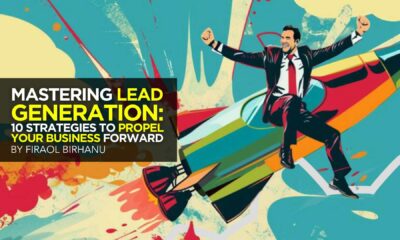









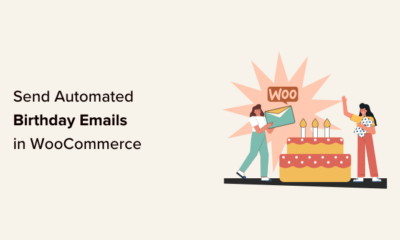



You must be logged in to post a comment Login